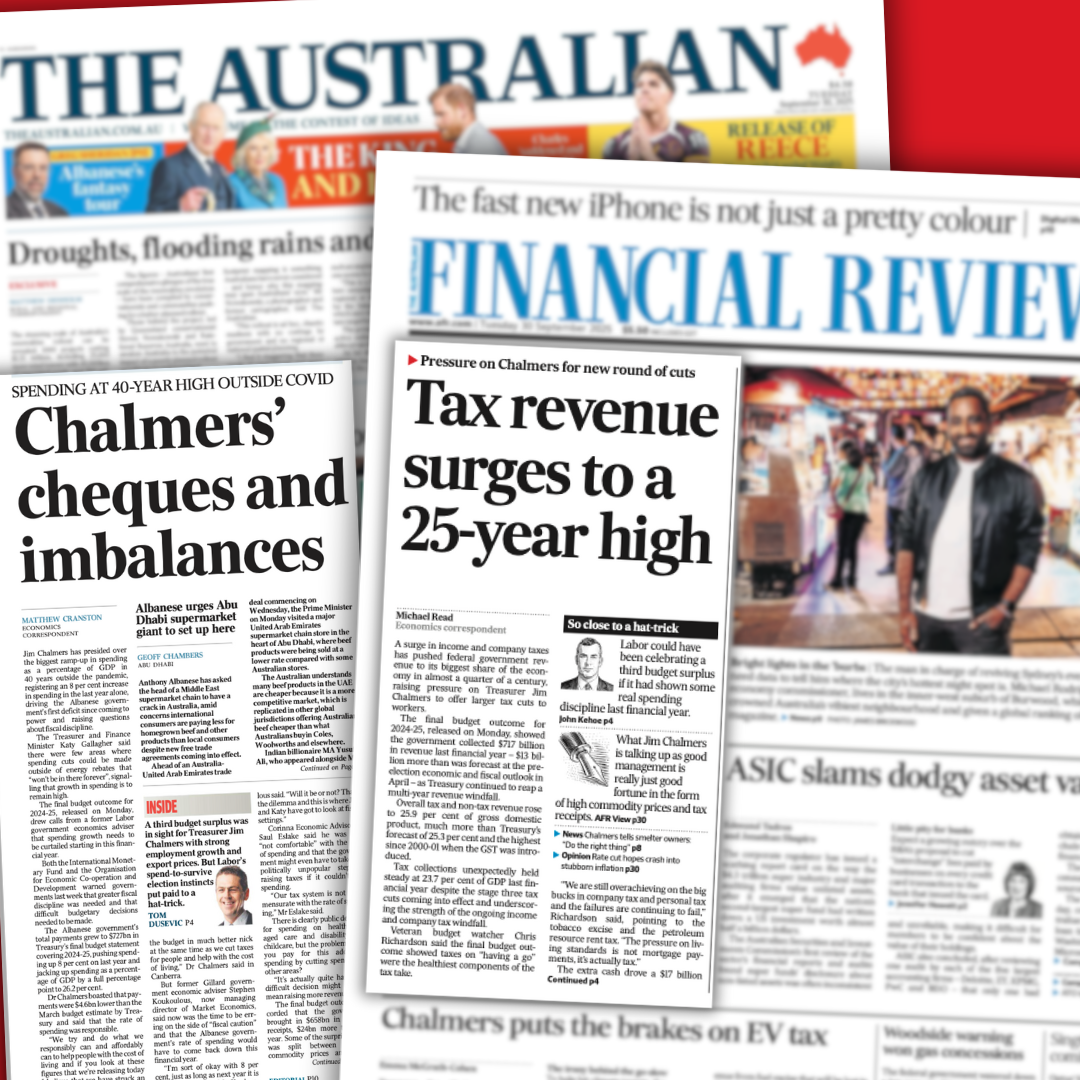Media
|
News

A surge in income and company taxes has pushed federal government revenue to its biggest share of the economy in almost a quarter of a century, raising pressure on Treasurer Jim Chalmers to offer larger tax cuts to workers.
The final budget outcome for 2024-25, released on Monday, showed the government collected $717 billion in revenue last financial year – $13 billion more than was forecast at the pre-election economic and fiscal outlook in April – as Treasury continued to reap a multi-year revenue windfall.
Overall tax and non-tax revenue rose to 25.9 per cent of gross domestic product, much more than Treasury’s forecast of 25.3 per cent and the highest since 2000-01 when the GST was introduced.
Tax collections unexpectedly held steady at 23.7 per cent of GDP last financial year despite the stage three tax cuts coming into effect and underscoring the strength of the ongoing income and company tax windfall.
Veteran budget watcher Chris Richardson said the final budget outcome showed taxes on “having a go” were the healthiest components of the tax take.
“We are still overachieving on the big bucks in company tax and personal tax and the failures are continuing to fail,” Richardson said, pointing to the tobacco excise and the petroleum resource rent tax.
“The pressure on living standards is not mortgage payments, it’s actually tax.”
The extra cash drove a $17 billion improvement in the budget bottom line compared to April, with the federal government recording a narrower-than-expected underlying deficit of $10 billion.
The underlying deficit figure does not include the $11.8 billion in so-called “off-budget spending” last year in areas such as the Snowy Hydro project and loss-making assets like the national broadband network and the Whyalla Steelworks. Including the off-budget spending the government’s headline deficit was $21.8 billion, also better than forecast.
Higher-than-expected commodity prices delivered an extra $5.3 billion in company taxes compared to Treasury’s forecast, while the strong jobs market saw income tax collections beat expectations by $3.4 billion. Strong investment earnings helped the government collect an extra $2.9 billion in taxes from superannuation funds.
Chalmers said the higher income tax take reflected the strength of the jobs market. Asked whether workers could expect another tax cut beyond the modest one announced in the March budget, Chalmers said he was enthusiastic about returning bracket creep where he could afford to do so, but stopped short of endorsing bigger tax cuts.
“We’ve shown that willingness not just on one occasion – not just on two occasions, but on three occasions,” Chalmers told reporters.
The so-called “top-up tax cuts” will save most workers about $5 per week from July 2026 before increasing to $10 per week from July 2027.
Chalmers also noted that tax receipts – a component of overall revenue – were still 23.7 per cent of GDP, below the 24.2 per cent peak reached during the life of the Howard government.
EY chief economist Cherelle Murphy said the final budget outcome raised questions about whether Australia’s tax collections were optimal.
“Do we want to be slugging households with bigger tax bills when the economy is healthy and they are earning more? Most economists think lower personal income taxes, but higher GST collections, would be a more effective mix,” she said.
At $727 billion, government spending came in $4.9 billion beneath Treasury’s forecasts from April, largely due to lower-than-expected grant payments to the states.
Despite the better-than-expected outcome, spending as a share of GDP still rose to 26.2 per cent of GDP last financial year, up from 25.2 per cent in 2023-24.
That was the highest level of government spending as a share of the economy since 1986-87, excluding the pandemic, when spending spiked due to temporary stimulus.
Shadow treasurer Ted O’Brien and opposition finance spokesman James Paterson said the budget would have recorded a $12 billion surplus instead of a $10 billion deficit if Labor had offset all of its new spending decisions with equivalent savings measures.
“Since coming to office, Labor has been the beneficiary of a record revenue windfall, totalling more than $370 billion over its first four budget years alone. Much of this is due to higher taxes via bracket creep on hardworking, everyday Australians,” the pair said in a statement.
“Jim Chalmers won the lotto and immediately went on a spending spree.”
The $11.8 billion in “off-budget” spending last financial year was well below Treasury forecasts for $19.1 billion, amid large under-spends at some of Labor’s signature investment vehicles.
These include the Clean Energy Finance Corporation, which spent $1 billion less than forecast, the National Reconstruction Fund ($1.1 billion less), and Housing Australia, which manages the Housing Australia Future Fund ($1 billion less).